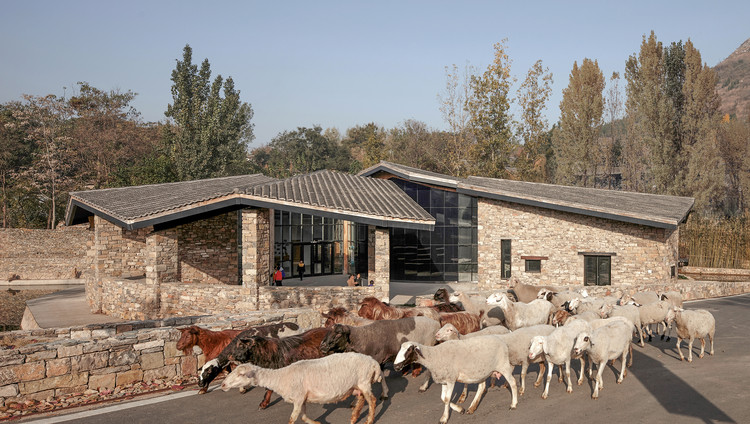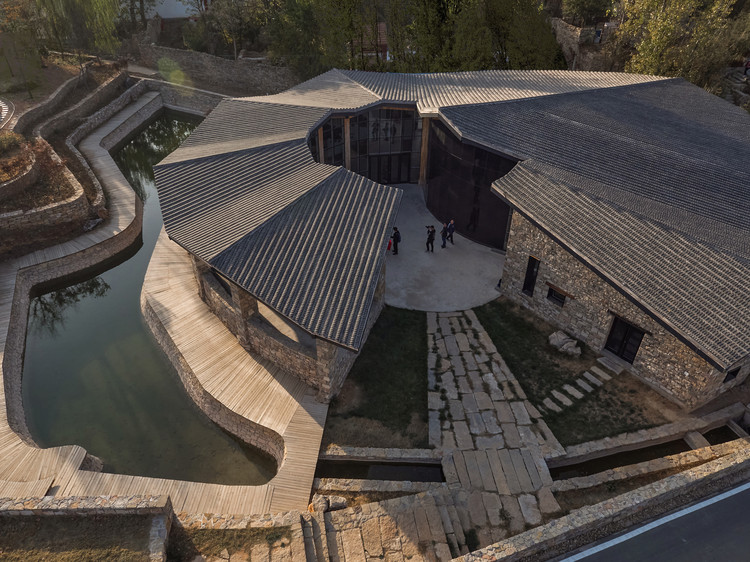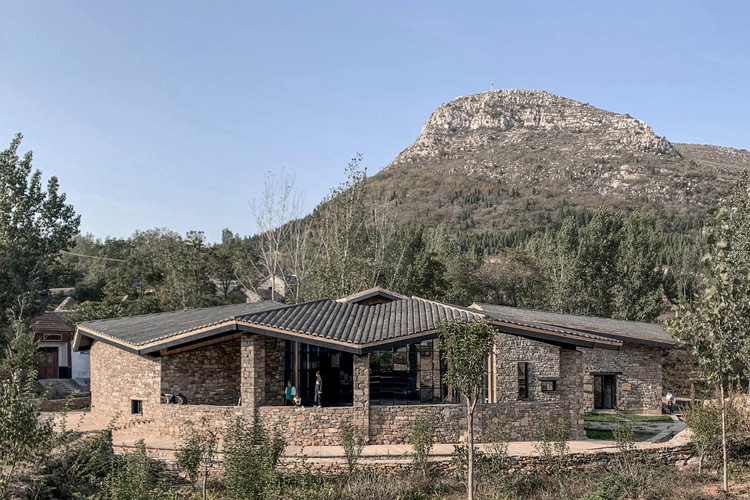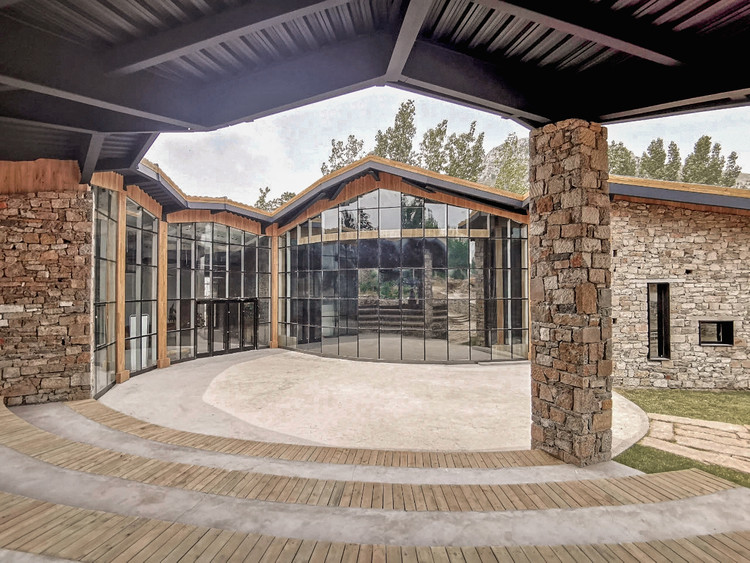Art
Dengxiangu Art Granary Concert Hall / VDA – ArchDaily
Dengxiangu Art Granary Concert Hall / VDA

Construction reasons. The Granary Concert Hall project is located in Jining City, Shandong Province, Sushui Dengxiangu art town, close to Dengxiangu Art Granary. The granary is a rectangular courtyard surrounded by several red tile stone houses, the previous function is used to preserve grain. Grain silo function after the abandonment of the cultural industry upgraded to become such as Art Granary. After nearly a decade of careful grinding, art granary has developed into a national village revitalization demonstration base. With the implementation and promotion of the national rural revitalization strategy, the internal space of the original granary transformation can no longer meet the increasing functional needs, so it is ready to build a new multi-functional building in the west side of the granary combined with the village, to meet the large-span space of 300-400 people.






After early research and discussion with the owners, according to the artistic characteristics of the granary, we finally decided to build a building full of human idealism in the mountains – granary concert hall. Since the project land is located between the art barn and the village, at the intersection of several main roads, the north-west side road connects the village, and the south-east side is adjacent to the public space of the granary art district, the geographical location determines that the concert hall will be the link between the art granary and the village. We hope that the concert hall will be open, inclusive, and diverse and that when completed, it will not only complement the functional needs of the art barn but also become a public open space for villagers to organize various activities. So how do we explain the connection between concert halls and art barns? How to respond to the harmonious relationship between building mass and the natural environment? What building materials are selected? With these questions, we design in the countryside, draw nutrients from the countryside, and try to find answers.




The Answers. Round granary: the overall and powerful building mass. The idea of the concert hall stems from the original function of the art barn: the granary. In combination with the land-use situation, the site is responded to with a circular building mass. The concert hall is like a big paddy pile, like growing out of the ground, full and full of shape, just filled the whole low-lying site; The change of architectural reality is unified under the big eaves of continuous turning, from any angle around can feel the sense of order and strength of the concert hall; Windows large and small on a pure stone façade are like a frame of view, which forms a beating wall of notes that solidify music in the building.






Emphasize the internal and external integration of architectural functions, both public activity space and communication space, convenient for the use of local residents. Geographical location and functional requirements have given the concert hall space layout of the cohesion, functional services of the outward radiation characteristics. In the architectural function layout, we have created a stage-centric circular building space, creating two performance spaces in indoor and outdoor, which can meet the needs of large indoor performance and meeting activities, while the large eaves of the outdoor continuous ups and downs combine the gray space, providing the villagers with summer cool and children playing space.




Emphasize the locality of the building, reflecting the building materials and the real state of the village. In the village to build a new house, we do not want her to be from abroad but hope that she can be a local building. So we emphasize the nature of the building, reflecting the real state of the village at present: the structure of the village to choose the common steel structure to present a large span of special space, building materials to choose local easy-to-use materials, the local have much stone, the village for decades of old houses are built of stone, so we use stone, green tile these very easy to find in the surrounding village building materials as a new building material, through the village stonemason original masonry, so that the new building presents a kind of local state: although not perfect. But relaxed enough to have an affinity.




Art
Art and Ephemera Once Owned by Pioneering Artist Mary Beth Edelson Discarded on the Street in SoHo – artnet News
This afternoon in Manhattan’s SoHo neighborhood, people walking along Mercer Street were surprised to find a trove of materials that once belonged to the late feminist artist Mary Beth Edelson, all free for the taking.
Outside of Edelson’s old studio at 110 Mercer Street, drawings, prints, and cut-out figures were sitting in cardboard boxes alongside posters from her exhibitions, monographs, and other ephemera. One box included cards that the artist’s children had given her for birthdays and mother’s days. Passersby competed with trash collectors who were loading the items into bags and throwing them into a U-Haul.
“It’s her last show,” joked her son, Nick Edelson, who had arranged for the junk guys to come and pick up what was on the street. He has been living in her former studio since the artist died in 2021 at the age of 88.
Naturally, neighbors speculated that he was clearing out his mother’s belongings in order to sell her old loft. “As you can see, we’re just clearing the basement” is all he would say.


Photo by Annie Armstrong.
Some in the crowd criticized the disposal of the material. Alessandra Pohlmann, an artist who works next door at the Judd Foundation, pulled out a drawing from the scraps that she plans to frame. “It’s deeply disrespectful,” she said. “This should not be happening.” A colleague from the foundation who was rifling through a nearby pile said, “We have to save them. If I had more space, I’d take more.”
Edelson’s estate, which is controlled by her son and represented by New York’s David Lewis Gallery, holds a significant portion of her artwork. “I’m shocked and surprised by the sudden discovery,” Lewis said over the phone. “The gallery has, of course, taken great care to preserve and champion Mary Beth’s legacy for nearly a decade now. We immediately sent a team up there to try to locate the work, but it was gone.”
Sources close to the family said that other artwork remains in storage. Museums such as the Guggenheim, Tate Modern, the Museum of Modern Art, the Brooklyn Museum, and the Whitney currently hold her work in their private collections. New York University’s Fales Library has her papers.
Edelson rose to prominence in the 1970s as one of the early voices in the feminist art movement. She is most known for her collaged works, which reimagine famed tableaux to narrate women’s history. For instance, her piece Some Living American Women Artists (1972) appropriates Leonardo da Vinci’s The Last Supper (1494–98) to include the faces of Faith Ringgold, Agnes Martin, Yoko Ono, and Alice Neel, and others as the apostles; Georgia O’Keeffe’s face covers that of Jesus.


A lucky passerby collecting a couple of figurative cut-outs by Mary Beth Edelson. Photo by Annie Armstrong.
In all, it took about 45 minutes for the pioneering artist’s material to be removed by the trash collectors and those lucky enough to hear about what was happening.
Dealer Jordan Barse, who runs Theta Gallery, biked by and took a poster from Edelson’s 1977 show at A.I.R. gallery, “Memorials to the 9,000,000 Women Burned as Witches in the Christian Era.” Artist Keely Angel picked up handwritten notes, and said, “They smell like mouse poop. I’m glad someone got these before they did,” gesturing to the men pushing papers into trash bags.
A neighbor told one person who picked up some cut-out pieces, “Those could be worth a fortune. Don’t put it on eBay! Look into her work, and you’ll be into it.”
Follow Artnet News on Facebook:
Want to stay ahead of the art world? Subscribe to our newsletter to get the breaking news, eye-opening interviews, and incisive critical takes that drive the conversation forward.
Art
Biggest Indigenous art collection – CTV News Barrie
[unable to retrieve full-text content]
Biggest Indigenous art collection CTV News Barrie





Source link
Art
Why Are Art Resale Prices Plummeting? – artnet News


Welcome to the Art Angle, a podcast from Artnet News that delves into the places where the art world meets the real world, bringing each week’s biggest story down to earth. Join us every week for an in-depth look at what matters most in museums, the art market, and much more, with input from our own writers and editors, as well as artists, curators, and other top experts in the field.
The art press is filled with headlines about trophy works trading for huge sums: $195 million for an Andy Warhol, $110 million for a Jean-Michel Basquiat, $91 million for a Jeff Koons. In the popular imagination, pricy art just keeps climbing in value—up, up, and up. The truth is more complicated, as those in the industry know. Tastes change, and demand shifts. The reputations of artists rise and fall, as do their prices. Reselling art for profit is often quite difficult—it’s the exception rather than the norm. This is “the art market’s dirty secret,” Artnet senior reporter Katya Kazakina wrote last month in her weekly Art Detective column.
In her recent columns, Katya has been reporting on that very thorny topic, which has grown even thornier amid what appears to be a severe market correction. As one collector told her: “There’s a bit of a carnage in the market at the moment. Many things are not selling at all or selling for a fraction of what they used to.”
For instance, a painting by Dan Colen that was purchased fresh from a gallery a decade ago for probably around $450,000 went for only about $15,000 at auction. And Colen is not the only once-hot figure floundering. As Katya wrote: “Right now, you can often find a painting, a drawing, or a sculpture at auction for a fraction of what it would cost at a gallery. Still, art dealers keep asking—and buyers keep paying—steep prices for new works.” In the parlance of the art world, primary prices are outstripping secondary ones.
Why is this happening? And why do seemingly sophisticated collectors continue to pay immense sums for art from galleries, knowing full well that they may never recoup their investment? This week, Katya joins Artnet Pro editor Andrew Russeth on the podcast to make sense of these questions—and to cover a whole lot more.
Follow Artnet News on Facebook:
Want to stay ahead of the art world? Subscribe to our newsletter to get the breaking news, eye-opening interviews, and incisive critical takes that drive the conversation forward.
-
Media14 hours ago
DJT Stock Rises. Trump Media CEO Alleges Potential Market Manipulation. – Barron's
-
Media16 hours ago
Trump Media alerts Nasdaq to potential market manipulation from 'naked' short selling of DJT stock – CNBC
-
Investment15 hours ago
Private equity gears up for potential National Football League investments – Financial Times
-



 Sports19 hours ago
Sports19 hours ago2024 Stanley Cup Playoffs 1st-round schedule – NHL.com
-



 Investment24 hours ago
Investment24 hours agoWant to Outperform 88% of Professional Fund Managers? Buy This 1 Investment and Hold It Forever. – The Motley Fool
-



 Health23 hours ago
Health23 hours agoToronto reports 2 more measles cases. Use our tool to check the spread in Canada – Toronto Star
-
Business15 hours ago
Gas prices see 'largest single-day jump since early 2022': En-Pro International – Yahoo Canada Finance
-
Real eState7 hours ago
Botched home sale costs Winnipeg man his right to sell real estate in Manitoba – CBC.ca








